Reclaiming a Past: Marino Marini and the (Non-)Classical Tradition
Claudia Daniotti Claudia Daniotti Marino Marini, Issue 5, May 2021https://italianmodernart-new.kudos.nyc/journal/issues/marino-marini/
Strongly rooted in the cultural and visual tradition of his home country, Marino Marini’s artistic production is the result of an uninterrupted dialogue with the art of the past, spanning from archaic Greece to Renaissance Italy, from imperial Rome to nineteenth-century European sculpture. In the vast repository of models that Marini drew upon, ancient art holds a significant place; rather than focusing, however, on the Greek and Roman artworks that fuelled artistic imaginations for centuries, from the 1920s Marini showed an interest in ancient civilizations outside of the established canon of classical antiquity, most notably those of ancient Etruria and Egypt. This appropriation is usually understood in connection with the widespread coeval fascination for archaic and pre-classical forms and as part of the Etruscan revival so proudly pursued by artists such as Arturo Martini and Massimo Campigli. Yet, little attention has been given to the momentous time at which Marini’s interest in such artifacts developed – a time of archaeological discoveries, flourishing scholarly literature, and the rearrangement of key museum collections that Marini had direct access to. By placing Marini’s interest, above all, in Etruscan artworks within the framework of the early twentieth-century cultural interest surrounding that civilization, this paper contributes to a richer understanding of Marini’s sculpture, locating his work more accurately on the map of the reception of antiquity in modern Italian art.
To an art historian such as myself, whose eye has been trained in the history and reception of the classical tradition, the work of Marino Marini appears immediately familiar, at very first glance.1 Its forms and themes speak a language so unmistakably rooted in the well-established cultural and visual traditions developed out of what we broadly call antiquity that one feels instantly at home. Yet, while his works come across as aesthetically remarkable, and could potentially be dismissed as uncomplicated, a second glance reveals that things are not as straightforward as they seem – suggesting that much lies beneath the surface. Scholars have long established that Marini’s oeuvre is the result of the very act of gazing into the ancient past in order to shape and contribute to the construction of a personal artistic identity; but the mechanisms of appropriation of that past remain unclear in many respects, for a case-by-case examination of Marini’s artifacts does not often allow their tracing back to less-than-generic clusters of visual references, let alone to precise individual sources of inspiration. And yet, the uninterrupted dialogue with the past entertained by Marini throughout his career makes him a particularly interesting case study in the reception of antiquity in twentieth-century Italy, particularly in the crucial interwar years. What seems to me most significant and worth exploring is not Marini’s dialogue with what we call “the classical tradition” – namely, the Greek and Roman antiquity that constitutes the “canon” of ancient art – but what I would call, for my purposes here, “the non-classical tradition” – that is, the antiquity which is neither Greek nor Roman, concerning instead other civilizations of the ancient world, most notably, for Marini, those of ancient Egypt and Etruria.2 This essay focuses on the complex relationship that Marini built in particular with the ancient Etruscans, whose art and culture have long been recognized as a major influence on his artistic production.3 This influence has been largely, and I believe correctly, understood as a range of technical and stylistic solutions adopted by Marini and also found in Etruscan art; yet, for the scholar concerned with the posthumous life of antiquity, the special relationship that Marini entertained with the Etruscans raises a number of other questions, having to do with the notion of what constitutes antiquity, the nature of the interplay with the past, and the construction of an identity, both personal and professional, in relation to a sense of belonging rooted in the past.
Marini’s attitude towards the art of the past has been eloquently described as driven by a “visual bulimia,”4 almost a physical need that urged him to explore with voracious enthusiasm all that museums, illustrated magazines, books, and other scholarly publications made available to him. References have been detected in Marini’s work to a vast array of sources, encompassing archaic Greek and China, imperial Rome and Renaissance Italy, Cycladic figurines and nineteenth-century European sculpture.5 Despite his nonselective, and rather omnivorous, interest in the art of the past, since the beginning of his career Marini demonstrated his special attention to both Etruscan and Egyptian art, as noted by his earliest critics and biographers, including Lamberto Vitali, Filippo De Pisis, and Guido Piovene.6
In 1917, when he began studying at the Accademia di Belle Arti in Florence, the antiquity that became part of Marini’s daily training as a sculptor was the classical kind, embodied in the academy’s collection of casts of Greek and Roman sculptures as well as in Neoclassical and nineteenth-century reinterpretations – alas often uninventive – of that antiquity.7 Marini’s twin sister, Egle, who enrolled in the Accademia with her brother, left a beautiful description of what those rooms in disrepair looked like during the war years, filled as they seemed to be with ghosts of a long-dead past:
In aule scolastiche di fortuna, dietro portici oscuri, c’era l’accumulato seccume dell’ “ottocento” autunnale, col freddo calco di gesso drappeggiato, il modello di carne, in piedi, che impugna un’asta come fosse un’alabarda e fantasmi residui di autori veramente morti.8
It was in the nearby Museo Archeologico Nazionale that Marini discovered another, non-classical antiquity. The collections from ancient Egypt and Etruria that were displayed there – still divided at the time into two distinct institutions, the Museo Egizio and the Museo Etrusco – offered examples of an ancient art outside the established canon and beyond the conventional repository of forms and themes his daily training at the Accademia provided. Later in life, Marini spoke often of the profound fascination Egyptian and Etruscan artifacts exerted onto him in his attempt to create an artistic language capable of reducing sculptural forms to their essential core, and that could convey a sense of the realism, the truthfulness, that he perceived to be missing in his own time and in need of recovering. Marini found, in the art of ancient Egypt and Etruria, answers to his questioning.9 Indeed, the works displayed at the Museo Archeologico possessed that aura of archaism much sought after by early twentieth-century artists. The influence that the monumentality embedded in Egyptian sculpture, even when of reduced size, had on Marini is best appreciated in his Hersilia (1930, but reworked in wood until 1949, Kunsthaus Zürich), while the geometric, essential forms of Egyptian heads and masks resonate in portraits such as his Lucosius (1935, Galleria Nazionale d’Arte Moderna e Contemporanea, Rome; another version is in the Museo del Novecento, Milan).10
Yet, it was among Etruscan works that Marini was most at ease. He felt close to the Etruscans, whom he eloquently called “miei padri più vivi, più attuali, più vicini a noi” (“my ancestors more alive, more relevant, closer to us”).11 Their realistic, unidealized representations of men and gods alike captivated Marini’s imagination, and their characteristic use of terracotta, often in polychrome, gave their artifacts the vividness, color, and warmth of life itself.12 Nothing could have contrasted more neatly the highly idealized, whitewashed antiquity he was trained upon at the Accademia than the art of the Etruscans Marini encountered at the Museo Archeologico – and later on, at the Museo Nazionale Etrusco di Villa Giulia in Rome. There is an additional element to his fascination with the Etruscans: as he said time and again throughout his life, Marini was an Etruscan himself, so he could rightly feel that they were, quite literally, his ancestors. Born and raised in Tuscany, on land that was once Etruria, he could naturally say “Io sono un etrusco” (“I am an Etruscan”).13 That proud statement, beyond being the declaration of an obvious biographical fact – and commonly heard even in present-day Tuscany and Latium – laid claim to a cultural and professional identity that Marini fashioned for himself.14
It is worth remembering that the Egyptian and Etruscan collections of the Museo Archeologico in Florence, which first fired Marini’s passion for those civilizations, remain to this day in Italy among the most remarkable in their remit. They are an excellent starting point for anyone interested in getting an insight into these civilizations. But at the beginning of the 1900s, when Marini came to know them, they were also regarded either as particularly prestigious because of their origins (in the case of the Egypt section) or as playing an instrumental role in the establishment of Etruscology as an academic discipline and a coherent subject of historical knowledge.
The Egyptian collection of the Museo Archeologico was largely put together in the 1820s, thanks to the efforts of Ippolito Rosellini, considered the father of Italian Egyptology.15 The collection was thoroughly researched and arranged as an evocative display by the great Ernesto Schiaparelli, who spent fourteen years in Florence, from 1880 to 1894, before becoming the director of the Museo Egizio in Turin.16 As for the Etruscan collection, its origins date centuries back, to the Medici. Alongside notable sarcophagi, alabaster urns, and a wealth of votive statuettes, it included famous bronzes such as the Chimera of Arezzo and the Arringatore (Orator), both unearthed in the sixteenth century. A fascination for Etruscan civilization was felt as early as ancient Rome, but it was only in the fifteenth and sixteenth centuries that a significant interest in their culture began to emerge – an interest which, in Medici Florence, particularly under Cosimo I, turned ultimately into ideological, dynastic, and politically charged appropriation.17 Over the following three centuries, the exploration of the lands once inhabited by the Etruscans, between Tuscany and the Latium,18 and the systematic excavation of their cemeteries, including the recovery and study of objects found in their tombs – most notably, in the necropolises of Tarquinia and Cerveteri – contributed both to an increased appreciation of Etruscan art and culture and to a romantic and somehow generic fascination, particularly felt in popular culture, for a civilization perceived as mysterious, enigmatic, and timeless.19
In the 1920s, that passionate enthusiasm, long-standing fascination, and methodical scholarship, along with a few groundbreaking archaeological discoveries, coalesced into the formation of Etruscology as an academic discipline; in Florence, the foundation of the Istituto di Studi Etruschi (born as the Comitato Permanente per l’Etruria, in 1925), the organization of the Primo Convegno Nazionale Etrusco (1926), and the publication of the annual journal Studi etruschi (beginning in 1927) were fundamental in promoting a more thorough investigation of Etruscan civilization.20 It was also in the 1920s that Etruscan culture first had significant impact on contemporary arts, above all sculpture, so much so that scholars and critics alike have spoken of the “Etruscan revival” of the 1920s and 1930s, particularly with relation to Marini, Arturo Martini, and Massimo Campigli.21 Artists were openly encouraged to turn to the Etruscans for inspiration, and visual sources to that effect were indeed easily available. Heavily illustrated and widely read periodicals like Dedalo, published from 1920 to 1933 under the direction of Ugo Ojetti, offered articles by leading voices in the field and a wealth of photographs of relevant artifacts. In addition, in the revised and much enlarged 1935 edition of his L’arte etrusca, the archaeologist Giulio Quirino Giglioli, who rose to fame for his 1916 discovery of the Apollo of Veii,22 presented his book as a tool useful not only to specialists but also, and more importantly, to artists, who were urged to make the most of the 1,115 monuments and artifacts illustrated in the volume’s more than 400 plates.23
Marini was therefore far from being the only artist, in the 1920s and 1930s, to be fascinated with the Etruscans. If the Museo Archeologico in Florence had, by all means, a pivotal role in Marini’s discovery of Etruscan art,24 he may also have been influenced by the collections of Villa Giulia in Rome, which famously fired the imaginations of both Martini and Campigli.25 It remains difficult, however, to establish with any degree of certainty what specific Etruscan artwork Marini saw or was particularly struck by, for almost no evidence survives of relevant drawings, sketches, or notes.26 In contrast to the very vocal Martini, who spoke enthusiastically of the time he spent at Villa Giulia,27 and in whose works the ancient Etruscan source is often easily identifiable,28 Marini left art historians deeply puzzled over which specific sources, models, and objects contributed more significantly to the shaping of his artistic language.
The terracotta group Popolo (People, 1929), now at the Museo del Novecento in Milan (figure 1),29 is most notable among Marini’s sculptures for its unquestionable connection to the Etruscans and is emblematic of the way in which he appropriated their art. Begun in 1929 and later significantly mutilated by the artist, some time before 1942 and again twenty years later, Popolo represents a Tuscan peasant couple embracing like the spouses that recline on the lids of Etruscan sarcophagi and cinerary urns. As Flavio Fergonzi has convincingly argued, Marini drew upon ancient Etruscan models – in particular, the lid of a cinerary urn, at the Museo Archeologico in Florence, which shows the deceased flanked by a female winged demon who holds the scroll whereupon his fate is written (figure 2) – and combined those sources with a mid-nineteenth-century bronze – namely Les Gracques by Eugène Guillaume (The Gracchi Brothers, 1848-1853), which Marini had seen in Paris – that relied in turn on ancient Roman models.30 In many respects, Popolo provides a good illustration of Marini’s artistic practice and of his nonreverential relationship to the traditions of the past: his works, including Popolo, possess an archaic flavor resulting from the contamination, rather than the quotation, of often disparate visual sources. Further, the mutilation Marini enacted upon many of his sculptures, including Popolo, eliminated overt reference to their underpinning visual models. With the removal of the couple’s arms, the key, and somehow narrative, gesture of holding hands, as borrowed from Guillaume’s bronze, is obliterated. In the end, what we are presented with is pieces that can be likened to fragments, created out of an almost archaeological sensibility, imbued with a sense of belonging and able to combine past and present without friction. The wife and husband, modeled on an Etruscan couple, are after all a couple of humble peasants Marini happened to meet in the Tuscan countryside.
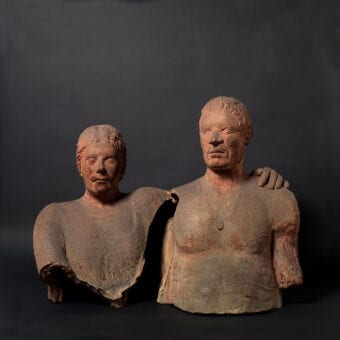
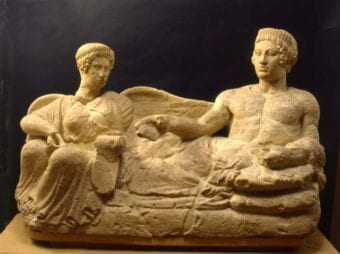
On the occasion of the 2017 exhibition Marino Marini: Passioni visive (Marino Marini: Visual Passions), which first located Marini’s production more precisely within the broader art historical context of 1920s to 1960s Italy, Barbara Cinelli strongly argued for a reassessment of the Etruscan connotations of Marini’s art, maintaining that such influence was limited to his formative years and not a more extensive reference point throughout his career.31 I wonder if, by taking into consideration themes rather than simply forms, this argument could open up to more nuances in Marini’s art. The subject matter of the Pomona, which Marini focused on between 1938 and 1949, is a case in point.32 In the first decades of the twentieth century, no European artist could tackle the Pomona as a subject without measuring it against the work of French sculptor Aristide Maillol, whose version of the mythic figure was a benchmark in the investigation of the female nude. What I will argue here is that for an artist such as Marini, who strongly claimed an Etruscan identity, the particular significance of the Pomona should not be overlooked.
According to ancient myth, Pomona was a nymph who presided over fruits, gardens, and orchards. Her name derives from the Latin pomum, meaning “apple.” Unlike most Roman gods and divine creatures, she has no Greek counterpart. According to ancient sources, chief among them Ovid’s Metamorphoses, from the first century, Pomona belongs to an age so remote that it preceded even the founding of Rome; she is therefore connected to an Italic, pre-Roman history distinct from the canonical Greco-Roman pantheon. Moreover, she is associated with Vertumnus, the Etruscan god of seasons and plant growth. Their love story, recounted by Ovid and illustrated in visual art over the centuries, is the most significant representation in the iconographic tradition concerning Pomona before the late nineteenth century.33 When represented alone, outside the narrative context of her story with Vertumnus, Pomona is typically shown holding apples, grapes, and other fruits that qualify her, broadly speaking, as a goddess of fertility; examples of this depiction include, for example, a first-century (clothed) statue in the Uffizi (figure 3) and a more essential Renaissance (unclothed) rendition (figure 4).34
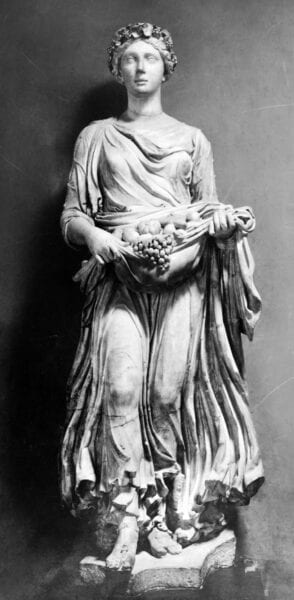
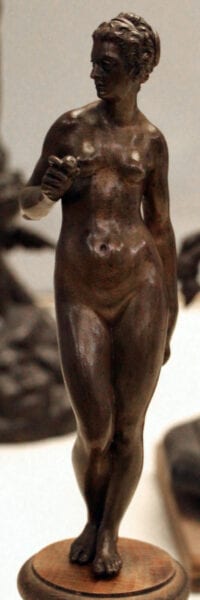
Rather unsurprisingly, in seventeenth- and eighteenth-century Europe, statues of Pomona often featured as decorative elements in gardens and other outdoor spaces; in the late nineteenth century, Pomona’s popularity gained new momentum in, above all, the work of Aristide Maillol.35 In so many of his sculptures the goddess can be identified as Pomona because of the apples she holds in her hands, for example a bronze from around 1909 that is now at the Philadelphia Museum of Art (figure 5). The ingenuity of Maillol’s reinvention of the theme can be well understood through the comparison of his figures to the more conventional La dea Pomona that Domenico Trentacoste, Marini’s teacher at the Accademia in Florence, sculpted in 1890 (figure 6).36 Though he did cast a few fully clothed Pomone – examples are at the Manchester Art Gallery and the San Francisco Museum of Modern Art – for Maillol the subject was essentially an opportunity to explore the female nude, and it was received as such by artists of Marini’s generation.

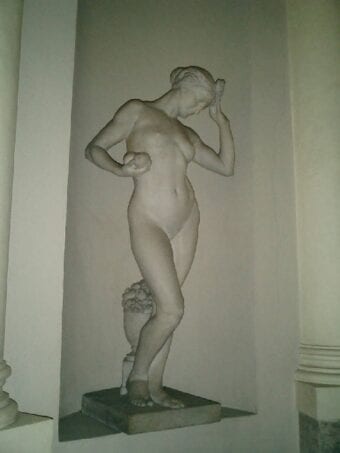
From a compositional point of view, the Pomona realized by Marini, including a now destroyed 1940 gesso (figure 7), openly declare their debt to Maillol, stepping away decisively from Trentacoste’s work, even if, as Chiara Fabi has noted,37 Marini had surely his teacher’s sculpture in mind when tackling the subject. More often than not, Marini stripped Pomona of the very attributes – the apples – that had been part of their iconography for centuries; this is the case with a 1941 bronze, with both its arms and head removed, that is now in Pistoia (figure 8).38 In another bronze version, from 1945 and also in Pistoia (figure 9), the apple is indeed present but hidden from direct view: in contrast with traditional versions that displayed the fruit in plain sight, this Pomona by Marini holds a tiny apple in her left hand, held behind her back. This unusual gesture has been tentatively related to the ancient, colossal Farnese Hercules (figure 10), whose right hand similarly holds behind his back the three apples from the Garden of the Hesperides.39
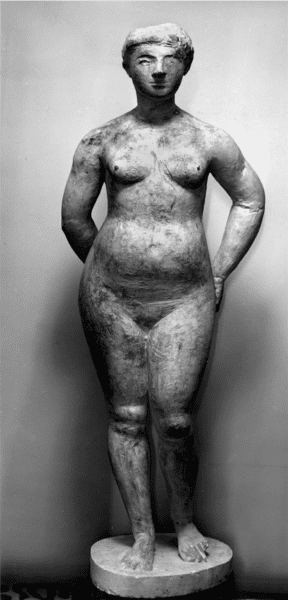
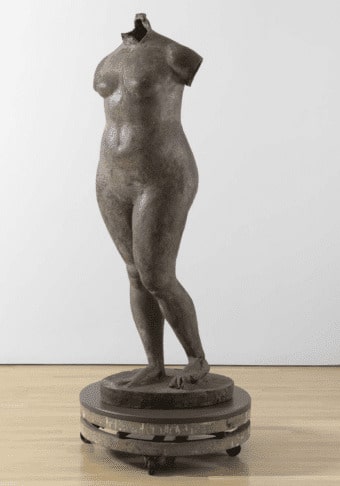
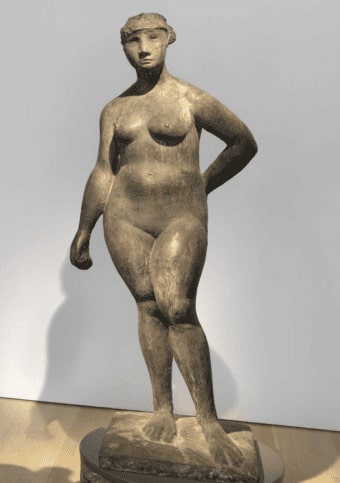
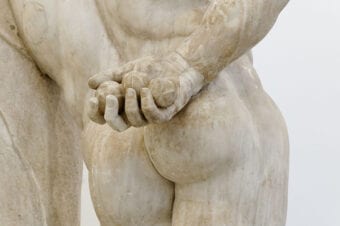
While the exact meaning of this iconographic detail remains problematic, a few general observations can be made. Unlike the Horses for which Marini is most famous, which turned into the highly dramatic Miracles, Pomona remains a positive, joyful subject in Marini’s oeuvre. Because of her protection of fruits and gardens, and her connection with fertility and the generative power of nature, Pomona embodies hope and new beginnings – even when the fruit she carries is hidden, as if symbolising a promising future which is still to come. To me it seems significant that Marini devoted himself to the subject of Pomona in the 1940s, and then stopped, never to resume it.40 In the long years during which the war raged and then dragged on, the figure of an ancient goddess, a bearer of hope untainted by the horrors unleashed around her, must have been a comforting presence for Marini to focus on. All the more so, I believe, because that goddess was ultimately Italic, more ancient than the Romans and more humane than the always-too-perfect Greeks. Ultimately, she was almost an Etruscan, like Marini himself.
As this essay has described, Marini built his personal and professional identity – better still, his persona – around an essentially Etruscan past, a non-classical antiquity, which he claimed as his own. It is likely that this claim was made, at least to some extent, against the even bolder one of Arturo Martini, who declared, in his native Veneto dialect, “Mi son el vero etrusco” (“I am the authentic Etruscan”).41 The legacy that Martini claimed on account of his own in-depth study of Etruscan art was to remain, in Marini’s eyes, defective – for nothing, as Marini playfully noted,42 could remedy to Martini’s birth outside of Tuscany, notwithstanding the artistic glories that the Veneto, too, could boast. The only artist who could rightfully claim to be the Etruscan par excellence, by choice and by birth, couldn’t possibly be the northerner Martini. In 2003, the sculptor Mimmo Paladino paid tribute to Marini with a large bronze sculpture inspired by the most famous of his themes: the horse mounted by a knight. The chosen title could not have been any clearer: L’Etrusco (Omaggio a Marino Marini).43
Bibliography
Alazard, Jean. “Aristide Maillol,” Dedalo 1 (August 1927–28): 178–98.
Aymonino, Adriano and Anne Varick Lauder. Drawn from the Antique: Artists & the Classical Ideal. London: Sir John Soane’s Museum, 2015. Exhibition catalogue.
Barbanera, Marcello. “Giglioli, Giulio Quirino.” In Dizionario Biografico degli Italiani, vol. 54, 707–11. Rome: Istituto della Enciclopedia Italiana, 2000.
Barbanera, Marcello. “‘Lo studio dell’arte etrusca era fermo al volume di Jules Martha.’ Le ricerche sugli Etruschi nel primo trentennio del Novecento.” In L’occhio dell’archeologo: Ranuccio Bianchi Bandinelli nella Siena del primo ‘900, edited by Marcello Barbanera, 17–31. Cinisello Balsamo: Silvana Editoriale, 2009.
Borsi, Franco, ed. Fortuna degli Etruschi. Milan: Electa, 1985. Exhibition catalogue.
Bruni, Stefano. “Etruscans.” In The Classical Tradition, edited by Anthony Grafton, Glenn W. Most, and Salvatore Settis, 338–42. Cambridge, MA, and London: Belknap Press of Harvard University Press, 2010.
Camporeale, Giovannangelo. “Dall’etruscheria all’etruscologia: appunti per un problema.” In Etruschi: Chiusi, Siena, Palermo. La collezione Bonci Casuccini, edited by Debora Barbagli and Mario Iozzo, 25–38. Siena: Protagon, 2007.
Camporeale, Giovannangelo. “La scoperta degli Etruschi nel Rinascimento.” Atene e Roma 48, no. 4 (2002): 145–65.
Carandente, Giovanni. “Marino Marini: l’intuizione.” In Marino Marini. Catalogo ragionato della scultura, edited by Giovanni Carandente, 9–19. Milan: Skira, 1998.
Casazza, Ornella and Riccardo Gennaioli, eds. Memorie dell’antico nell’arte del Novecento. Florence: Giunti, 2009. Exhibition catalogue.
Cassese, Giovanna, ed. Accademie Patrimoni di Belle Arti. Rome: Gangemi Editore, 2013.
Chastel, André. “L’‘Etruscan revival’ du XVe siècle.” Revue Archéologique 1 (January–June 1959): 165–80.
Cinelli, Barbara. “Marino Marini e la critica. Qualche fonte, una mancata storiografia e una leggenda.” In Marino Marini: Passioni visive, edited by Cinelli and Fergonzi, 40–61.
Cinelli, Barbara and Flavio Fergonzi, eds. Marino Marini: Passioni visive. Confronti con i capolavori della scultura dagli Etruschi a Henry Moore. Cinisello Balsamo: Silvana Editoriale, 2017. Exhibition catalogue.
Cipriani, Giovanni. Il mito etrusco nel Rinascimento fiorentino. Florence: Olschki, 1980.
Corgnati, Martina. L’ombra lunga degli etruschi. Echi e suggestioni nell’arte del Novecento. Monza: Johan & Levi Editore, 2018.
De Lorenzi, Giovanna. “Firenze, la Francia e le arti figurative fra Otto e Novecento.” Artista (2007): 58–73.
De Lorenzi, Giovanna. “Su alcune sculture di Domenico Trentacoste.” Artista 2 (1990): 192–207.
Del Vesco, Paolo and Beppe Moiso, eds. Missione Egitto 1903–1920. L’avventura archeologica M.A.I. raccontata. Turin and Modena: Franco Cosimo Panini Editore, 2017. Exhibition catalogue.
Dennis, George. The Cities and Cemeteries of Etruria. London: J. Murray, 1848.
Fabi, Chiara. Marino Marini. La Collezione del Museo del Novecento. Cinisello Balsamo: Silvana Editoriale, 2015.
Farinella, Vincenzo. “Adolfo Balduini e la ‘fortuna degli Etruschi’ intorno al 1920.” In Adolfo Balduini nel Novecento toscano, edited by Nadia Marchioni, 49–61. Pisa: Edizioni ETS, 2006.
Farinella, Vincenzo. “‘Vedere il sole attraverso occhi di terracotta’: alcune fonti archeologiche della scultura di Marino Marini.” In Marino Marini: Passioni visive, edited by Cinelli and Fergonzi, 62–85.
Fergonzi, Flavio. “Prima della fama internazionale. Temi della ricerca scultorea di Marino Marini tra gli anni trenta e i quaranta.” In Marino Marini: Passioni visive, edited by Cinelli and Fergonzi, 12–39.
Fergonzi, Flavio. “Rodin e gli scultori italiani (1889–1915). 1.” Prospettiva 89–90 (January–April 1998): 40–73.
Fergonzi, Flavio. “‘L’uomo più assimilatore che si conosca.’ Martini e l’uso delle fonti visive.” In Filologia del 900. Modigliani, Sironi, Morandi, Martini, 217–60. Milan: Mondadori Electa, 2013.
Gáldy, Andrea M. Cosimo I de’ Medici as Collector: Antiquities and Archaeology in Sixteenth-Century Florence. Newcastle, U.K.: Cambridge Scholars Publishing, 2009.
Giglioli, Giulio Quirino. L’arte etrusca. Milan: Fratelli Treves, 1935.
Giglioli, Giulio Quirino. “Statue fittili di età arcaica.” Notizie degli Scavi di Antichità 1, 2, 3 (1919): 13–37.
Giglioli, Giulio Quirino and Pericle Ducati. Arte etrusca. Rome and Milan: Società editrice d’arte illustrata, 1927.
Grossi, Federica. “Gli Etruschi di Arturo Martini: rielaborazioni d’avanguardia.” In Fascino etrusco nel primo Novecento, conversando di arti e di storia delle arti. Atti dell’incontro di Studio, Milano, Università degli Studi, Sala Crociera Alta (7 ottobre 2015), edited by Giovanna Bagnasco Gianni, 111–42. Milan: Ledizioni, 2016.
Guzzetti, Francesco, ed. “Marino Marini. Antologia di dichiarazioni e scritti editi 1935–1979.” In Marino Marini: Passioni visive, edited by Cinelli and Fergonzi, 208–41.
Haack, Marie-Laurence, ed. La construction de l’étruscologie au début du XXe siècle. Actes des journées d’études internationales des 2 et 3 décembre 2013 (Amiens). Pessac Bourdeaux: Ausonius, 2015.
Harari, Maurizio. “Cultura moderna e arte etrusco-italica.” Rivista storica italiana 105 (1993): 730–43.
La fortuna degli Etruschi nella fotografia dell’800. Gli Archivi Alinari. Edited by Gerhild Huebner. Florence: Alinari, 1985.
Lawrence, David Herbert. Etruscan Places. London: Martin Secker, 1932.
L’uomo nero. Materiali per una storia delle arti della modernità 6 (December 2008): 5–139 (monographic issue “Numero etrusco”).
Mannini, Lucia. “La riscoperta degli Etruschi e della Chimera tra le due guerre.” In Una Chimera del Novecento. Il leone di Monterosso di Arturo Martini, edited by Lucia Mannini and Anna Mazzanti, 5–10. Florence: Polistampa, 2017.
Marini, Egle. “Omaggio a Marino Marini” (1974). In Marino Marini, Pensieri sull’arte: scritti e interviste, edited by Marina Marini, 9–17. Milan: All’Insegna del Pesce d’Oro, 1998.
Marini, Marino. Sono etrusco. Confessioni e pensieri sull’arte. Edited by Staffan Nihlén. Pistoia: Via del Vento, 1996.
Marino Marini, presentato da Filippo De Pisis. Milan: Edizioni della Conchiglia, 1941.
Marino Marini: Arcadian Nudes. New York: Center for Italian Modern Art, 2019. Exhibition catalogue.
Marino Marini. Personaggi del XX secolo. Milan: Centro Studi Piero della Francesca, 1972.
Marino Marini. Pomone e nudi femminili. Pistoia: Fondazione Marino Marini, 1991. Exhibition catalogue.
Marino Marini: ritratti. Sculture, opere su carta. Milan: Electa, 1991. Exhibition catalogue.
Martini, Arturo. Colloqui sulla scultura 1944–45 raccolti da Gino Scarpa. Edited by Nico Stringa. Treviso: Canova, 1997.
Meller, Peter. “Un gruppo di bronzetti di Pierino da Vinci del 1547.” Mitteilungen des Kunsthistorischen Institutes in Florenz 18. 2 (1974): 251–72.
Moiso, Beppe, Maria Cristina Guidotti, Federico Poole, and Egle Micheletto. “Schiaparelli egittologo, soprintendente e filantropo.” In Missione Egitto 1903–1920. L’avventura archeologica M.A.I. raccontata, edited by Paolo Del Vesco and Beppe Moiso, 37–57. Turin and Modena: Franco Cosimo Panini Editore, 2017. Exhibition catalogue.
Montevago, Laura. “Etruschi interlocutori di Marino Marini? Fonti dirette e indirette alla ricerca di un rapporto.” Tesi di laurea triennale, Università degli Studi di Milano, 2016–17.
Piovene, Guido. “Marino Marini.” Civiltà 11 (October 1942): 57–64.
Pirovano, Carlo. Marino Marini scultore. Milan: Electa, 1972.
Pola, Angela. “Album fotografici e ispirazione artistica. Le pubblicazioni archeologiche degli anni Venti-Trenta del Novecento e le fonti di ispirazione degli artisti neo etruschi.” In Fascino etrusco nel primo Novecento, conversando di arti e di storia delle arti. Atti dell’incontro di Studio, Milano, Università degli Studi, Sala Crociera Alta (7 ottobre 2015), edited by Giovanna Bagnasco Gianni, 51–109. Milan: Ledizioni, 2016.
Pontiggia, Elena and Mario Quesada, eds. L’idea del classico 1916–1932. Temi classici nell’arte italiana degli anni Venti. Milan: Fabbri Editori, 1992. Exhibition catalogue.
Pratesi, Mauro. “Scultura italiana verso gli anni trenta e contemporanea rivalutazione dell’arte etrusca.” Bollettino d’Arte 28 (1984): 91–106.
Pratesi, Mauro. “Sulle tracce degli Etruschi: l’arte e la critica negli anni Venti e Trenta del Novecento.” Prospettiva 46 (July 1986): 80–85.
Rosellini, Ippolito. I monumenti dell’Egitto e della Nubia. 9 vols. Pisa: Presso N. Capurro, 1832–44.
Russo, Gianmarco. “I nudi femminili e le Pomone.” In Marino Marini: Passioni visive, edited by Cinelli and Fergonzi, 122–37.
Salvador, Fabiana. “Maillol e l’Italia: diffusione dell’opera e fortuna critica dal Salon d’Automne al 1930.” AFAT: Arte in Friuli arte a Trieste 31 (2012): 181–94.
Sapori, Francesco. Scultura italiana moderna. Rome: Libreria dello Stato, 1949.
Schiaparelli, Ernesto. Museo Archeologico di Firenze. Antichità egizie ordinate e descritte (parte prima). Rome: Tipografia della R. Accademia dei Lincei, 1887.
Settis, Salvatore. Futuro del “classico.” Turin: Einaudi, 2004.
Settis, Salvatore, with Anna Anguissola and Davide Gasparotto, eds. Serial/Portable Classic: The Greek Canon and Its Mutations. Milan: Fondazione Prada, 2015. Exhibition catalogue.
Talking Along the Nile: Ippolito Rosellini, Travellers and Scholars of the 19th-Century in Egypt. Proceedings of the International Conference Held on the Occasion of the Presentation of Progetto Rosellini. Pisa, June 14–16, 2012, edited by Marilina Betrò and Gianluca Miniaci. Pisa: Pisa University Press, 2013.
Uzielli, Gustavo. “Artisti contemporanei: Domenico Trentacoste,” Emporium 9, no. 52 (April 1899): 243–61.
Uzzani, Giovanna. “Marino Marini e la fortuna dell’arte etrusca.” In Pistoia, Montale, Quarrata: il nostro Novecento, 21–31. Florence: Polistampa, 2017.
Vitali, Lamberto. Marino Marini. Milan: Hoepli, 1937.
- In researching and writing this essay I incurred many debts, the greatest of them to my dear friend and colleague Nicol Maria Mocchi, who generously shared her knowledge and answered countless questions about everything even remotely connected to twentieth-century art. For helping me with several bibliographical requests, thanks are due to my friends Gemma Cornetti, Elisa Bastianello, Paolo Sachet, and Livia Lupi, as well as to Alessandro Oldani of the Galleria d’Arte Moderna in Milan and to Barbara Stabielli of the Biblioteca dell’Accademia Albertina di Belle Arti in Turin. My gratitude goes also to Laura Mattioli, Flavio Fergonzi, and the staff at CIMA, for all that I learned from them during my fellowship there.
- On the long process that ultimately resulted, in the early nineteenth century, in the definition of “classical antiquity” (and therefore “classical art”), its identification with the Greek and Roman antiquity, and its establishment as an academic discipline, see the excellent status quaestionis offered by Salvatore Settis, Futuro del “classico” (Turin: Einaudi, 2004), especially 61–73, with further bibliography. Much material is also in Salvatore Settis, with Anna Anguissola and Davide Gasparotto, eds., Serial/Portable Classic: The Greek Canon and Its Mutations (Milan: Fondazione Prada, 2015). On a rather different matter that is kept in the background here – namely, the early twentieth-century debate about the idea of classic – see Elena Pontiggia and Mario Quesada, eds., L’idea del classico 1916–1932. Temi classici nell’arte italiana degli anni Venti (Milan: Fabbri Editori, 1992); interesting material is also discussed in Ornella Casazza and Riccardo Gennaioli, eds., Memorie dell’antico nell’arte del Novecento (Florence: Giunti, 2009).
- On Marini and Etruscan art, see Martina Corgnati, L’ombra lunga degli etruschi. Echi e suggestioni nell’arte del Novecento (Monza: Johan & Levi Editore, 2018), 88–99; Angela Pola, “Album fotografici e ispirazione artistica. Le pubblicazioni archeologiche degli anni Venti-Trenta del Novecento e le fonti di ispirazione degli artisti neo etruschi,” in Fascino etrusco nel primo Novecento, conversando di arti e di storia delle arti. Atti dell’incontro di Studio, Milano, Università degli Studi, Sala Crociera Alta (7 ottobre 2015), ed. Giovanna Bagnasco Gianni (Milan: Ledizioni, 2016), 51–109; and Giovanna Uzzani, “Marino Marini e la fortuna dell’arte etrusca,” in Pistoia, Montale, Quarrata: il nostro Novecento (Florence: Polistampa, 2017), 21–31. Relevant material is also conveniently gathered in Laura Montevago, “Etruschi interlocutori di Marino Marini? Fonti dirette e indirette alla ricerca di un rapporto” (tesi di laurea triennale, Università degli Studi di Milano, 2016–17).
- Vincenzo Farinella, “‘Vedere il sole attraverso occhi di terracotta’: alcune fonti archeologiche della scultura di Marino Marini,” in Marino Marini: Passioni visive. Confronti con i capolavori della scultura dagli Etruschi a Henry Moore, ed. Barbara Cinelli and Flavio Fergonzi (Cinisello Balsamo: Silvana Editoriale, 2017), 72. As he acknowledged (84 n. 46), Farinella borrowed the expression “bulimia nervosa” from Flavio Fergonzi, who had in turn first applied it to Arturo Martini.
- The key reference is now Cinelli and Fergonzi, eds., Marino Marini: Passioni visive, which has first provided a thorough investigation into Marini’s artistic practice, showing how much it relied on constant dialogue with iconographic traditions of the past.
- Lamberto Vitali, Marino Marini (Milan: Hoepli, 1937), especially 13–14; Marino Marini, presentato da Filippo De Pisis (Milan: Edizioni della Conchiglia, 1941); and Guido Piovene, “Marino Marini,” Civiltà 11 (October 1942): 57–64.
- For an overview of the rich collections of casts belonging to the Italian academies, see Giovanna Cassese, ed., Accademie Patrimoni di Belle Arti (Rome: Gangemi Editore, 2013); the Florence Academy is discussed on 46–67. On the study of the antique and its didactic role in artistic education, see Adriano Aymonino and Anne Varick Lauder, Drawn from the Antique: Artists & the Classical Ideal (London: Sir John Soane’s Museum, 2015).
- “In makeshift classrooms, behind the dark arcades [of the academy’s courtyard], the sterile dryness of a decadent ‘nineteenth century’ had piled up, with the cold plaster cast draped in its cloth, the live model, standing and holding a rod as if it were a halberd, and ghosts of truly dead authors still lingering on” (the translation is mine). For the original text, see Egle Marini, “Omaggio a Marino Marini” (1974), in Marino Marini, Pensieri sull’arte. Scritti e interviste, ed. Marina Marini (Milan: All’Insegna del Pesce d’Oro, 1998), 12. The emphasis is mine.
- See, in particular, Piero Bargellini’s 1971 recollection of the visits he paid to the Museo Archeologico in Marini’s company, when the two were both students at the Accademia: “[Speaking to Marini] Ma quando si avvertiva la necessità di riprendere contatto con le forme, quasi primigenie, chi poteva darci questo contatto? E chiaro, lì vicino, il Museo Etrusco e quello Egiziano. Ricordi quando si andava davanti ai bassorilievi egiziani così plasticamente essenziali? Era uno shock. E c’è stata una fase ‘etrusco-egiziana’, proprio perché c’è stata la ripresa di contatto con i valori che poi furono chiamati valori ‘tattili’.” Bargellini’s memoir, published by Carlo Ludovico Ragghianti in 1985, can now be read in Francesco Guzzetti, ed., “Marino Marini. Antologia di dichiarazioni e scritti editi 1935–1979,” in Cinelli and Fergonzi, Marino Marini: Passioni visive, 233–34, no. 34.
- These works are discussed in the light of possible Egyptian models in Farinella, “‘Vedere il sole attraverso occhi di terracotta,’” 72–76. Aurelio Amendola’s remarkable photographs of Hersilia are published in Carlo Pirovano, Marino Marini scultore (Milan: Electa, 1972), figures 43, 44 and 45, while a photograph of the first and now lost Hersilia, in gesso and wood, is in Marino Marini, presentato da Filippo De Pisis, figure 15. On Marini’s portraits in general, see Marino Marini. Personaggi del XX secolo (Milan: Centro Studi Piero della Francesca, 1972) and Marino Marini: ritratti. Sculture, opere su carta (Milan: Electa, 1991).
- I quote from the conversation with Marini and others published by Ragghianti in 1985 (see note 9), see Guzzetti, “Marino Marini. Antologia di dichiarazioni,” 233: “Dirò che io ero più vicino agli Etruschi perché gli Egiziani mi facevano paura: erano l’assoluto, e allora ne avevo un grande spavento. Quando ne guardavo le opere così precise, così assolute, scappavo e andavo dai miei padri più vivi, più attuali, più vicini a noi, insomma.”
- The qualification of terracotta as a peculiarly Etruscan material goes back to Pliny the Elder (Naturalis Historia XXXV.157), who testifies to the significant use of terracotta made by Etruscan artists and mentions Vulca as the most gifted among them.
- Of the many occasions when Marini declared himself an Etruscan, the most notable is a 1961 interview with the Swedish sculptor Staffan Nihlén. Asked about his “Etruscan inspiration,” Marini emphatically replied: “No, io non sono ispirato! Io sono etrusco!” See Marino Marini, Sono etrusco. Confessioni e pensieri sull’arte, ed. Staffan Nihlén (Pistoia: Via del Vento, 1996), 9.
- Of the many labels given to Marini in the art world, the label “Etruscan artist” has surely been favored, but not by all. In the United States, for example, after the war he was called “the Chinese artist.” See Guzzetti, “Marino Marini. Antologia di dichiarazioni,” 218, no. 18.
- For Ippolito Rosellini, who shared with Jean-François Champollion, the decipherer of the hieroglyphs, the directorship of the 1828–1829 archaeological mission to Egypt funded by the Gran Duke of Tuscany Leopold II to broaden the museum’s collections, see Talking Along the Nile: Ippolito Rosellini, Travellers and Scholars of the 19th-Century in Egypt. Proceedings of the International Conference Held on the Occasion of the Presentation of Progetto Rosellini. Pisa, June 14–16, 2012, ed. Marilina Betrò and Gianluca Miniaci (Pisa: Pisa University Press, 2013). A native of Pisa, Rosellini taught for several years at his hometown university, holding, as of 1826, the first chair of Egyptology established in Italy. The results of his expedition to Egypt were published in the nine-volume I monumenti dell’Egitto e della Nubia (Pisa: Presso N. Capurro, 1832–44), while the thousands of papers, drawings, and handwritten notes he made in Egypt were bequeathed to the university’s library, where they are still kept today.
- On Ernesto Schiaparelli, see Paolo Del Vesco and Beppe Moiso, eds., Missione Egitto 1903–1920. L’avventura archeologica M.A.I. raccontata (Turin and Modena: Franco Cosimo Panini Editore, 2017), especially the essay by Beppe Moiso, Maria Cristina Guidotti, Federico Poole, and Egle Micheletto, “Schiaparelli egittologo, soprintendente e filantropo,” 37–57. Schiaparelli authored the first catalogue of the museum’s Egyptian collection, of which only the first volume was published: Museo Archeologico di Firenze. Antichità egizie ordinate e descritte (parte prima) (Rome: Tipografia della R. Accademia dei Lincei, 1887). Photographs of the museum arrangement devised by Schiaparelli can be found in La fortuna degli Etruschi nella fotografia dell’800. Gli Archivi Alinari, ed. Gerhild Huebner (Florence: Alinari, 1985), 10–13.
- For a general overview of the Etruscans’ fortuna up to the present, see Stefano Bruni, “Etruscans,” in The Classical Tradition, ed. Anthony Grafton, Glenn W. Most, and Salvatore Settis (Cambridge, MA, and London: Belknap Press of Harvard University Press, 2010), 338–42, and Franco Borsi, ed., Fortuna degli Etruschi (Milan: Electa, 1985). For the Medici’s interest in the Etruscan world in particular, see André Chastel, “L’‘Etruscan revival’ du XVe siècle,” Revue Archéologique 1 (January–June 1959): 165–80; Giovanni Cipriani, Il mito etrusco nel Rinascimento fiorentino (Florence: Olschki, 1980); Giovannangelo Camporeale, “La scoperta degli Etruschi nel Rinascimento,” Atene e Roma 48, no. 4 (2002): 145–65; and Andrea M. Gáldy, Cosimo I de’ Medici as Collector: Antiquities and Archaeology in Sixteenth-Century Florence (Newcastle, U.K.: Cambridge Scholars Publishing, 2009), especially chapter 4.
- Here the pioneering work of George Dennis should be mentioned: The Cities and Cemeteries of Etruria, first published in London in 1848 and reprinted several times since.
- On this eighteenth- and nineteenth-century age of discovery, see Giovannangelo Camporeale, “Dall’etruscheria all’etruscologia: appunti per un problema,” in Etruschi: Chiusi, Siena, Palermo. La collezione Bonci Casuccini, ed. Debora Barbagli and Mario Iozzo (Siena: Protagon, 2007), 25–38. Most influential in terms of the vivid description of ancient Etruria as a land of spellbinding fascination is the travel account of David Herbert Lawrence, Etruscan Places (London: Martin Secker, 1932).
- See Marie-Laurence Haack, ed., La construction de l’étruscologie au début du XXe siècle. Actes des journées d’études internationales des 2 et 3 décembre 2013 (Amiens) (Pessac Bourdeaux: Ausonius, 2015); and Marcello Barbanera, “‘Lo studio dell’arte etrusca era fermo al volume di Jules Martha’. Le ricerche sugli Etruschi nel primo trentennio del Novecento,” in L’occhio dell’archeologo: Ranuccio Bianchi Bandinelli nella Siena del primo ‘900, ed. Marcello Barbanera (Cinisello Balsamo: Silvana Editoriale, 2009), 17–31. Additional material is in the monographic issue “Numero etrusco” of L’uomo nero. Materiali per una storia delle arti della modernità 6 (December 2008): 5–139.
- From the vast literature, see the excellent contributions by Corgnati, L’ombra lunga degli etruschi, and Bagnasco Gianni, ed., Fascino etrusco nel primo Novecento, with its bibliography. See also Mauro Pratesi, “Scultura italiana verso gli anni trenta e contemporanea rivalutazione dell’arte etrusca,” Bollettino d’Arte 28 (1984): 91–106, and his “Sulle tracce degli Etruschi: l’arte e la critica negli anni Venti e Trenta del Novecento,” Prospettiva 46 (July 1986): 80–85; Maurizio Harari, “Cultura moderna e arte etrusco-italica,” Rivista storica italiana 105 (1993): 730–43; and Vincenzo Farinella, “Adolfo Balduini e la ‘fortuna degli Etruschi’ intorno al 1920,” in Adolfo Balduini nel Novecento toscano, ed. Nadia Marchioni (Pisa: Edizioni ETS, 2006), 49–61.
- Unearthed on May 19, 1916 – during the excavation of the sanctuary of Portonaccio, near Veii, north of Rome – the Etruscan polychrome terracotta statue of Apollo was soon displayed at the Museo Nazionale Etrusco di Villa Giulia and remains to this day a highlight of that collection. Its discovery, made known only in 1919 (Giulio Quirino Giglioli, “Statue fittili di età arcaica,” Notizie degli Scavi di Antichità 1, 2, 3 [1919]: 13–37) revolutionized the understanding of Etruscan art, so much so that, according to Francesco Sapori (Scultura italiana moderna [Rome: Libreria dello Stato, 1949], 53) “qualcuno scrisse che nell’immaginazione degli scultori italiani l’Apollo di Veio ha trionfato a una cert’ora sull’Apollo del Belvedere. E non aveva torto!”
- See Giulio Quirino Giglioli, L’arte etrusca (Milan: Fratelli Treves, 1935), 35. By comparison, the first edition of Arte etrusca, published in 1927 and authored by Giglioli with Pericle Ducati, contained 153 plates only. The importance of the 1935 edition can hardly be overestimated, as it contained “il più grande repertorio di immagini e di documentazione bibliografica fin allora disponibile” on Etruscan art. See Marcello Barbanera, “Giglioli, Giulio Quirino,” in Dizionario Biografico degli Italiani, vol. 54 (Rome: Istituto della Enciclopedia Italiana, 2000), 710.
- A rather extraordinary claim was made by Angela Pola (“Album fotografici e ispirazione artistica,” 64–65) and repeated by Corgnati (L’ombra lunga degli etruschi, 89) and Montevago (“Etruschi interlocutori”, 13) that Marini was involved in the rearrangement of the Etruscan section of the Florence museum. To the best of my knowledge, this statement is unsupported; I believe it may originate in a misreading of Giovanni Carandente, “Marino Marini: l’intuizione,” in Marino Marini. Catalogo ragionato della scultura, ed. Giovanni Carandente (Milan: Skira, 1998), 9–19. On page 16, such rearrangement is discussed but rightly ascribed to Ernesto Schiaparelli.
- See Corgnati, L’ombra lunga degli etruschi, 50–60 (on Martini) and 75–88 (on Campigli).
- Two drawings of Etruscan sarcophagi made by Marini are illustrated in Marino Marini, presentato da Filippo De Pisis, s.p.
- See Arturo Martini, Colloqui sulla scultura 1944–45 raccolti da Gino Scarpa, ed. Nico Stringa (Treviso: Canova, 1997), 146. On Martini’s interest in Etruscan art, see Federica Grossi, “Gli Etruschi di Arturo Martini: rielaborazioni d’avanguardia,” in Fascino etrusco nel primo Novecento, ed. Bagnasco Gianni, 111–42.
- For instance, his Leone di Monterosso (Chimera), 1933–1935, Florence, Museo Novecento; see Lucia Mannini, “La riscoperta degli Etruschi e della Chimera tra le due guerre,” in Una Chimera del Novecento. Il leone di Monterosso di Arturo Martini, eds. Lucia Mannini and Anna Mazzanti (Florence: Polistampa, 2017), 5–10. On Martini’s visual sources in general, fundamental is Flavio Fergonzi, “‘L’uomo più assimilatore che si conosca.’ Martini e l’uso delle fonti visive,” in Filologia del 900. Modigliani, Sironi, Morandi, Martini (Milan: Mondadori Electa, 2013), 217–60.
- See the relevant catalogue entry in Chiara Fabi, Marino Marini. La Collezione del Museo del Novecento (Cinisello Balsamo: Silvana Editoriale, 2015), 34–35, with further bibliography.
- Flavio Fergonzi, “Prima della fama internazionale. Temi della ricerca scultorea di Marino Marini tra gli anni trenta e i quaranta,” in Cinelli and Fergonzi, Marino Marini: Passioni visive, 20–21. Additional Etruscan sources that may have been available to Marini through the mid-1920s scholarly publications are discussed in Pola, “Album fotografici e ispirazione artistica,” 102–05, figures 14–17.
- Barbara Cinelli, “Marino Marini e la critica. Qualche fonte, una mancata storiografia e una leggenda,” in Cinelli and Fergonzi, Marino Marini: Passioni visive, 40–61; of the same opinion is Pola, “Album fotografici e ispirazione artistica,” 53, note 7. Contra, see Corgnati, L’ombra lunga degli etruschi, 93 and 212, note 171.
- On Marini’s female nudes, including his Pomona, see Gianmarco Russo, “I nudi femminili e le Pomone,” in Cinelli and Fergonzi, Marino Marini: Passioni visive, 122–37, as well as Marino Marini: Arcadian Nudes (New York: Center for Italian Modern Art, 2019) and Marino Marini. Pomone e nudi femminili (Pistoia: Fondazione Marino Marini, 1991).
- Ovid Metamorphoses, XIV.623–771. For more on this visual tradition, see the Iconographic Database of the Warburg Institute, London, accessible at https://iconographic.warburg.sas.ac.uk/vpc/VPC_search/results_basic_search.php?p=1&var_1=pomona. It is also worth noticing that an Etruscan statuette of Vertumnus is kept in the Museo Archeologico in Florence.
- On this bronze statuette, which is paired to a Bacchus, see Peter Meller, “Un gruppo di bronzetti di Pierino da Vinci del 1547,” Mitteilungen des Kunsthistorischen Institutes in Florenz 18.2 (1974): 251–72.
- On Maillol and the widespread knowledge of his work in Italy in the 1910s to 1930s, see Jean Alazard, “Aristide Maillol,” Dedalo 1 (August 1927–28): 178–98; Fabiana Salvador, “Maillol e l’Italia: diffusione dell’opera e fortuna critica dal Salon d’Automne al 1930,” AFAT: Arte in Friuli arte a Trieste 31 (2012): 181–94; and Giovanna De Lorenzi, “Firenze, la Francia e le arti figurative fra Otto e Novecento,” Artista (2007): 58–73.
- On Trentacoste, though with no reference to his Pomona, see Gustavo Uzielli, “Artisti contemporanei: Domenico Trentacoste,” Emporium 9, 52 (April 1899): 243–61; Giovanna De Lorenzi, “Su alcune sculture di Domenico Trentacoste,” Artista 2 (1990): 192–207; and Flavio Fergonzi, “Rodin e gli scultori italiani (1889–1915). 1,” Prospettiva 89–90 (January–April 1998): 40–73.
- Fabi, Marino Marini, entry no. 7.12. In 1935, Trentacoste’s Pomona was gifted to the Galleria d’Arte Moderna in Milan, to which it still belongs. It must have been known to Marini, who moved to Milan in 1929.
- On another version of the work, in the Museo del Novecento in Milan, see ibid., entry no. 7.12.
- The connection has been made by Ann Kuttner, in a lecture she delivered on February 11, 2020, at the CIMA event “The Pasts of Marini’s Futures.”
- For the 1966 interview with Gino Montesanto, when Marini declared that the time of the Pomona was over and that he would never be able to go back to the theme, see Guzzetti, “Marino Marini. Antologia di dichiarazioni,” 228, no. 29. A few years earlier, in 1959, Marini had stated that he could no longer create any of his female nudes, whom he felt had no place in a world so radically changed by war: “Potrei rifare, anche oggi, quei gentili nudi femminili; ma sarebbero come spaesati, e io stesso non impegnerei più che la mia mano. Il mondo e la società non sono più quelli di allora, è avvenuto qualcosa per cui quella grazia è perduta” (see ibid., 215–16, no. 17, quote from page 216).
- Martini, Colloqui sulla scultura, 147.
- Marini recalled, in 1972, his many conversations with Martini: “Dicevo sempre: ‘Arturo tu sei nato nel Veneto: che fregatura!’” See Guzzetti, “Marino Marini. Antologia di dichiarazioni,” 237, no. 36.
- See Corgnati, L’ombra lunga degli etruschi, 181.

